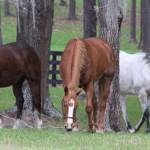Optimizing Horse Pasture Management: Advantages and Drawbacks

Are you using your pasture to its full potential? Optimizing grazing areas enhances a horse’s quality of life and overall health, and helps save money on preserved forages.
In a survey of pasture management practices in Florida, the advantages of using pasture proved as plentiful as the fields themselves. The 36-question survey collected demographic information (number of horses, primary breed, acreage), forage utilization (type of forage fed, origin of hay), and pasture management practices (type of management, including stocking rates, mowing, and overseeding).
As horse owners can attest, feeding horses can be expensive. One way to lower the cost of managing horses is through the thoughtful use of pasture. More specifically, keeping horses on pasture can cost considerably less than preserved forages, such as traditional hay, hay cubes, and hay pellets.
Pasture allows horses an environment that “promotes natural behavior, increased feeding motivation, and decreased incidence of aberrant behaviors,” according to the researchers. In addition, horses that are turned out on pasture have less exposure to dust from hay, which is especially important for those with compromised breathing.
Simply using available pasture, however, does not ensure that your horse will be healthier.
“If pastures are not managed appropriately, grazing horses may not consume sufficient nutrients,” advised Kathleen Crandell, Ph.D., a nutritionist for Kentucky Equine Research.
In the study, only 6% of respondents had their pasture forage analyzed for nutrient analysis. “Analysis of forages, be it for pasture or purchased hay, makes diet formulation more science than guesswork and will ensure each horse’s nutritional requirements are met,” Crandell relayed.
Further, pasture management practices such as rotating grazing areas, ensuring appropriate stocking rates, fertilizing, liming, and overseeding with more than one species of grass or legumes are not used to their fullest potential. Again, this means that even when horses are turned out they may not be consuming all required nutrients.
“Whenever possible, soils and forage should be analyzed. Horses can then be offered high-quality concentrates or targeted supplementation to fill any nutritional voids,” Crandell recommended.
*Vasco, A.C.C.M., J.C.B. Dubeux, Jr., M.O. Wallau, C.L. Wickens, and L.K. Warren. 2020. Characterization of forage utilization and pasture management practices on Florida horse operations. Journal of Equine Veterinary Science 95:103253.








